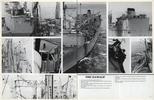 |
Search the Site with

|
USS Ranger (CV 61)
- formerly CVA 61 -- decommissioned -
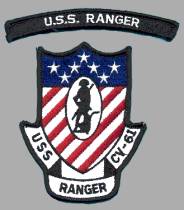
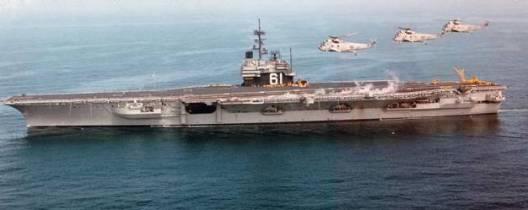
USS RANGER was the third ship in the FORRESTAL - class and the second carrier in the Navy to bear this name. Commissioned as attack aircraft carrier CVA 61, the RANGER was redesignated as multi-purpose aircraft carrier CV 61 on June 30, 1975. USS RANGER was last homeported in San Diego, Calif. After decommissioning the RANGER was laid-up at the Naval Inactive Ship Maintenance Facility at Bremerton, Wash., awaiting possible future use as a museum ship. The museum plans, however, were canceled and on December 22, 2014, the RANGER was sold for scrapping to International Shipbreaking Ltd. of Brownsville, Tx., for one cent. On March 5, 2015, the RANGER left Bremerton, Wash., under tow enroute to Brownsville, Tx., where she arrived on July 12, 2015. Scrapping at Brownsville was finished on November 1, 2017.
| General Characteristics: | Keel Laid: August 2, 1954 |
| Launched: September 29, 1956 | |
| Commissioned: August 10, 1957 | |
| Decommissioned: July 10, 1993 | |
| Builder: Newport News Shipbuilding Co., Newport News, Va. | |
| Propulsion system: eight boilers | |
| Rudders: two | |
| Propellers: four | |
| Blades on each Propeller: five | |
| Aircraft elevators: four | |
| Catapults: four | |
| Arresting gear cables: four | |
| Length, overall: 1,063 feet (324 meters) | |
| Flight Deck Width: 250,3 feet (76.3 meters) | |
| Beam: 129 feet (39.3 meters) | |
| Draft: 37,7 feet (11.3 meters) | |
| Displacement: approx. 78,200 tons full load | |
| Speed: 30+ knots | |
| Planes: approx. 85 | |
| Crew: Ship: approx. 2,700 Air Wing: 2,480 | |
| Armament: three Mk 29 NATO |
Crew List:
This section contains the names of sailors who served aboard USS RANGER. It is no official listing but contains the names of sailors who submitted their information.
- Click here to view the list.
- Click here
to see which USS RANGER memorabilia are currently for sale on ebay.
USS RANGER Cruise Books and Pamphlets:
- Maiden Cruise Book
- WestPac 1959 Cruise Book
- WestPac 1960 Cruise Book
- WestPac 1961-62 Cruise Book
- WestPac 1962-63 Cruise Book
- WestPac 1964-65 Cruise Book
- WestPac 1965-66 Cruise Book
- WestPac 1967-68 Cruise Book
- WestPac 1968-69 Cruise Book
- WestPac 1969-70 Cruise Book
- WestPac 1970-71 Cruise Book
- WestPac 1972-73 Cruise Book
- WestPac 1974 Cruise Book
- WestPac 1976 Cruise Book
- WestPac 1979 Cruise Book
- WestPac 1980-81 Cruise Book
- WestPac 1982 Cruise Book
- 1985-86 Cruise Book
- WestPac 1987 Cruise Book
- WestPac 1989 Cruise Book
- Operation Desert Storm 1990-91 Cruise Book
- WestPac 1992-93 Cruise Book
- Decommissioning Pamphlet
Accidents aboard USS RANGER:
| Date | Where | Events | ||||||
|---|---|---|---|---|---|---|---|---|
| November 10, 1958 | Off San Francisco, Calif. | USS RANGER suffers an explosion in the magazine area seven decks below the waterline while off San Francisco, Calif., killing two. A careless act by two crewmen trying to obtain gunpowder from the magazine to fuel a miniature jet engine they had built caused the explosion. The Navy said the two men were known rocket enthusiasts and were not authorized to be in the magazine area at the time of the explosion. The "relatively minor" damage takes about a month to repair due to the location of the accident. | ||||||
| April 1959 | Pacific | Because of a short circuit there was a fire aboard the carrier. During this fire an explosion of fuel gases occurred. Two crewmen died and 15 were injured. | ||||||
| July 1, 1962 | Off California | An F8U Crusader aircraft crashed into the USS RANGER, injuring two. | ||||||
| April 5, 1963 | Off Japan | Boiler uptake explosion while going between Japanese ports. | ||||||
| September 1964 | Off Vietnam | Boiler explosion on Yankee Station. 51 days repair. | ||||||
| April 13, 1965 | Off Vietnam | During a fire in the main machinery room, one crewman died. During the incident the carrier was on station off Vietnam. | ||||||
| March 6, 1971 | Off Vietnam | While on Yankee Station a member of the carrier's flight deck force was blown over the side during launching operations. USS TOWERS (DDG 9), providing plane-guard service for RANGER, quickly sped to the scene, rescued the sailor, and returned him to his ship. | ||||||
| July 18, 1972 | Pacific Ocean | Sabotage of engine during routine sea duty. | ||||||
| December 13, 1972 | Off Vietnam | USS RANGER suffers a fire in the main machinery room while the ship operates off Vietnam. The fire takes two hours to control. | ||||||
| 1976 | Subic Bay, Philippines | USS RANGER suffered a serious fire (class delta, aircraft flare) in the O3 level while in port at Subic Bay, no fatalities. Information by Alan Bedard, former USS RANGER crewmember who helped fighting the fire. | ||||||
| July/August 1976 | Indian Ocean | While responding to the Entebbe/Uganda incident USS RANGER suffered a class Bravo fire in one of her shaft allies that disabled her port outboard shaft for 4 days until replacement parts could be flown in and installed. Sabotage was suspected. Information by Alan Bedard, former USS RANGER crewmember. | ||||||
| February 20, 1977 | Puget Sound Naval Shipyard, Wash. | USS RANGER experiences a Class Alpha fire in the anchor machinery room while drydocked at Puget Sound Naval Shipyard, Wash. | ||||||
| December 6, 1978 | Off Baja, Calif. | USS RANGER experiences an explosion and flash fire during fleet exercises which result in minor burns to nine crewmen. | ||||||
| March 29, 1979 | Subic Bay Area, Philippines | USS RANGER suffers a main engine turbine casualty requiring extensive repair while training in the Subic Bay operations area. | ||||||
| April 5, 1979 | Near the eastern approaches to the Straits of Malacca | USS RANGER collides with the Liberian tanker FORTUNE suffering substantial damage to her bow but no injuries while the tanker is holed in the port side from the main deck to the waterline. Following the collision USS RANGER's CO was relieved by Capt. Roger E. Box, USN. The collision is also covered in RANGER's WestPac Cruise Book 1979. The two pages are linked below:  | ||||||
| August 6, 1981 | San Diego, Calif. | Fire in Pri-Fly area while at San Diego. | ||||||
| July 18, 1983 | 100 miles off San Diego, Calif. | RANGER collides with USS WICHITA (AOR 1) during refueling. RANGER's flight deck elevator is damaged, but no injuries are reported. USS WICHITA damages its refueling capability. The port fueling riggins are put out of commission, including the loss of all fuel hoses. Also part of WICHITA's aft superstructure is crushed on the starboard side. The photos below are from USS WICHITA's cruise book 1983-84 and document the collision:
| ||||||
| August 18, 1983 | Off Nicaragua | Crewman blown overboard by jet exhaust. | ||||||
| November 1, 1983 | Arabian Gulf | A fire breaks out aboard USS RANGER while deployed in the Arabian Gulf, killing 6 and injuring 35. The fire is in one of the four main machinery spaces and reportedly is extinguished within an hour although there is one reflash which is extinguished. USS RANGER continues operations in the area. | ||||||
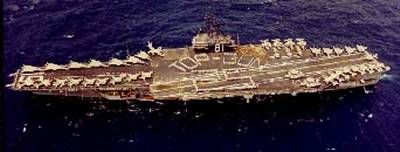
USS RANGER Patch Gallery:
 |  |  |  |  |
 |  | Click here for more USS RANGER Patches. | ||
History of USS RANGER:
USS RANGER was laid down 2 August 1954 by Newport News Shipbuilding and Drydock Co., Newport News, Va.; launched 29 September 1956; sponsored by Mrs. Arthur Radford, wife of Admiral Radford, Chairman of the Joint Chiefs of Staff; and commissioned at the Norfolk Naval Shipyard 10 August 1957, Capt. Charles T. Booth II, in command.
RANGER joined the Atlantic Fleet 3 October 1957. Just prior to sailing 4 October for Guantanamo Bay, Cuba, for shakedown, she received the men and planes of Attack Squadron 85. She conducted air operations, individual ship exercises, and final acceptance trials along the eastern seaboard and in the Caribbean Sea until 20 June 1958. She then departed Norfolk, Va., with 200 Naval Reserve officer candidates for a two-month cruise that took the carrier around Cape Horn. She arrived at her new homeport, Alameda, Calif., on 20 August and joined the Pacific Fleet.
The carrier spent the remainder of 1958 in pilot qualification training for Air Group 14 and fleet exercises along the California coast. Departing 3 January 1959 for final training in Hawaiian waters until 17 February, she next sailed as the flagship of Rear Adm. H. H. Caldwell, ComCarDiv 2, to join the Seventh Fleet. Air operations off Okinawa were followed by maneuvers with SEATO naval units out of Subic Bay. A special weapons warfare exercise and a patrol along the southern seaboard of Japan followed. During this first WestPac deployment, RANGER launched more than 7,000 sorties in support of Seventh Fleet operations. She returned to San Francisco Bay 27 July.
During the next six months, RANGER kept herself in a high state of readiness through participation in exercises and coastal fleet operations. With Carrier Air Group 9 embarked, she departed Alameda 6 February 1960 for a second WestPac deployment and returned to Alameda 30 August. From 11 August 1961 through 8 March 1962, RANGER deployed to the Far East a third time.
The next seven months were filled with intensive training along the western seaboard in preparation for operations in the troubled waters of Southeast Asia. RANGER departed Alameda on 9 November 1962 for brief operations off Hawaii, and then proceeded, via Okinawa, to the Philippines. She steamed to the South China Sea 1 May 1963 to support possible Laotian operations. When the political situation in Laos relaxed 4 May, she resumed her operations schedule with the Seventh Fleet.
Arriving at Alameda from the Far East 14 June 1963, she underwent overhaul in the San Francisco Naval Shipyard 7 August 1963 through 10 February 1964. Refresher training out of Alameda commenced 25 March, interrupted by an operational cruise to Hawaii from 19 June to 10 July.
Ranger again sailed for the Far East 6 August 1964. This deployment came on the heels of the unprovoked assault against USS MADDOX (DD 731) on the night of 2 August and, two nights later, against both MADDOX and USS TURNER JOY (DD 951), by North Vietnamese motor torpedo boats. In retaliation for this aggression on the high seas by North Vietnam, President Lyndon B. Johnson, on 5 August, directed the Navy to strike bases used by the North Vietnamese naval craft. As RANGER steamed from the western seaboard, some 60 attack sorties rose from the decks of USS TICONDEROGA (CVA 14) and USS CONSTELLATION (CVA 64).
RANGER made only an eight-hour stop in Pearl Harbor 10 August 1964, then hurried on to Subic Bay, and then to Yokosuka, Japan. In the latter port on 17 October 1964, she became flagship of Rear Adm. Miller who commanded Fast Carrier Task Force 77. In the following months, she helped the Seventh Fleet continue its role of steady watchfulness to keep open the sealanes for the Allies and stop Communist infiltration by sea.
On 7 February 1965, in retaliation for a damaging Viet Cong attack on installations around Pleiku, a fighter bomber strike, launched from RANGER, USS CORAL SEA (CV 43), and USS HANCOCK (CV 19), blasted the military barracks and staging areas near Dong Hoi in the southern sector of North Vietnam.
Gen. William Westmoreland, commanding the Military Advisory Command in Vietnam, visited RANGER on 9 March 1965 to confer with Rear Adm. Miller. RANGER continued air strikes on enemy inland targets until 13 April when a fuel line broke, ignited and engulfed her No. 1 main machinery room in flames. The fire was extinguished in little over an hour. There was one fatality. RANGER put into Subic Bay 15 April and sailed on the 20th for Alameda, arriving home on 6 May. She entered the San Francisco Naval Shipyard 13 May 1965 and remained there under overhaul until 30 September.
Following refresher training, RANGER departed Alameda on 10 December 1965 to rejoin the Seventh Fleet. She and her embarked Carrier Air Wing 14 received the Navy Unit Commendation for exceptionally meritorious service during combat operations in Southeast Asia from 10 January to 6 August 1966.
RANGER departed the Gulf of Tonkin 6 August for Subic Bay, and steamed via Yokosuka for Alameda, arriving on the 25th. She stood out of San Francisco Bay 28 September and entered Puget Sound Naval Shipyard two days later for overhaul. The carrier departed Puget Sound 30 May 1967 for training out of San Diego and Alameda. On 21 July 1967, she logged her 88,000th carrier landing.
From June until November, RANGER underwent a long and intensive period of training designed to make her fully combat ready. Attack Carrier Air Wing 2 (CVW-2) embarked on 15 September 1967, with the new A-7 Corsair II jet attack plane and the UH-2C Seasprite turboprop rescue helicopter, making RANGER the first carrier to deploy with these powerful new aircraft. From carrier refresher training for CVW-2, RANGER proceeded to fleet exercise Moon Festival. From 9 to 16 October 1967, the carrier and her air wing participated in every aspect of a major fleet combat operation.
Her efficiency honed to a fine edge, RANGER departed Alameda 4 November 1967 for WestPac. Arriving Yokosuka 21 November, she relieved USS CONSTELLATION and sailed for the Philippines on the 24th. After arriving at Subic Bay on 29 November, she made final preparations for combat operations in the Tonkin Gulf. Commander, Carrier Division 3, embarked on 30 November as Commander, TG 77.7; and RANGER departed Subic Bay on 1 December for Yankee Station.
Arriving on station 3 December 1967, RANGER commenced another period of sustained combat operations against North Vietnam. During the next 5 months, her planes hit a wide variety of targets, including ferries, bridges, airfields and military installations. Truck parks, rail facilities, antiaircraft guns and SAM sites were also treated to doses of Air Wing 2's firepower. Bob Hope's "Christmas Show" came to RANGER in Tonkin Gulf on 21 December. Another welcome break in the intense pace of operations came with a call at Yokosuka during the first week of April 1968. Returning to Yankee Station on 11 April 1968, RANGER again struck objectives in North Vietnam.
After five months of intensive operations, RANGER called at Hong Kong 5 May 1968 and then steamed for home. There followed a shipyard availability at Puget Sound that ended with RANGER's departure 29 July for San Francisco. Three months of leave, upkeep and training culminated in another WestPac deployment 26 October 1968 through 17 May 1969. She departed Alameda on yet another WestPac deployment in December 1969 and remained so employed until 18 May 1970 at which time she returned to Alameda, arriving 1 June 1970.
RANGER spent the rest of the summer engaged in operations off the west coast, departing for her sixth WestPac cruise 27 September 1970. On 10 March 1971, RANGER, along with USS KITTY HAWK (CV 63), set a record of 233 strike sorties for one day in action against North Vietnam. During April, the three carriers assigned to Task Force 77 - RANGER, KITTY HAWK, and HANCOCK - provided a constant two-carrier posture on Yankee Station. Hours of employment remained unchanged with one carrier on daylight hours and one on the noon to midnight schedule. Strike emphasis was placed on the interdiction of major Laotian entry corridors to South Vietnam. She returned to Alameda 7 June 1971 and remained in port for the rest of 1971 and the first five months of 1972 undergoing regular overhaul.
On 27 May 1972 she returned to west coast operation until 16 November, when she embarked upon her seventh WestPac deployment. On 18 December 1972 Linebacker II operations were initiated when negotiations in the Paris peace talks stalemated. Participating carriers were RANGER, USS ENTERPRISE (CVN 65), USS SARATOGA (CV 60), USS ORISKANY (CV 34), and USS AMERICA (CV 66).
The Linebacker II operations ended on 29 December when the North Vietnamese returned to the peace table. These operations involved the resumed bombing of North Vietnam above the 20th parallel and was an intensified version of Linebacker I. The reseeding of the mine fields was resumed and concentrated strikes were carried out against surface-to-air missile and antiaircraft artillery sites, enemy army barracks, petroleum storage areas, Haiphong naval and shipyard areas, and railroad and truck stations. Navy tactical air attack sorties under Linebacker II were centered in the coastal areas around Hanoi and Haiphong. There were 505 Navy sorties in this area during Linebacker II. Between 18 and 22 December the Navy conducted 119 Linebacker II strikes in North Vietnam. Bad weather was the main limiting factor on the number of tactical air strikes flown during Linebacker II.
On 27 January 1973, the Vietnam cease-fire, announced four days earlier, came into effect and ORISKANY, AMERICA, ENTERPRISE and RANGER, on Yankee Station, cancelled all combat sorties into North and South Vietnam. During the U.S. involvement in the Vietnam conflict (starting in 1961 and ending on 2 January 1973) the Navy lost 726 fixed-wing aircraft and 13 helicopters to hostile action. The Marine Corps lost 193 fixed-wing aircraft and 270 helicopters to enemy action during the same period. Operation Homecoming, the repatriation of U.S. POWs between 27 January and 1 April 1973, began and North Vietnam and the Viet Cong released 591 POWs. Of the 591 POWs released during Operation Homecoming, 145 were Navy personnel, all but one of whom were Naval Aviation personnel.
RANGER returned to Alameda in August 1973 and remained in that area through 7 May 1974 when she deployed again to the western Pacific, returning to homeport on 18 October. On 28 May 1976, while on deployment, helicopters crews from HS-4 aboard RANGER, detachments from HC-3 on USS CAMDEN (AOE 2), USS MARS (AFS 1) and USS WHITE PLAINS (AFS 4), and helicopters from NAS Cubi Point, Republic of the Philippines, assisted in Philippine disaster relief efforts in the flood ravaged areas of central Luzon. Over 1,900 people were evacuated; more than 370,000 pounds of relief supplies and 9,340 gallons of fuel were provided by Navy and Air Force helicopters. As a side note, before the relief operations the RANGER was trapped in port Subic Bay, Philippines, by the typhoon and 3 days were spent trying to keep the carrier off the docks. That happened because the storm made a sudden course change and the RANGER was not able to get enough boilers on line in time to leave port. The typhoon eventually damaged the docks and one of the 3 tugs that were trying to keep the RANGER off suffered a failure and explosion in the tug's engine room that RANGER's damage control team responded to.
4 July was spent in port Singapore and the RANGER had just departed the harbor by a few hours when the carrier got the call to proceed to Kenya in response to a threat of military action in Kenya by Ugandan forces. The battle group proceeded at best speed out running the Soviet shadow and even her own supply group. That brought along that the carrier conducted an UNREP from a US Merchant Marine super tanker while heading for the coast of Kenya. On 12 July 1976, RANGER and her escort ships of Task Force 77.7 entered the Indian Ocean and were assigned to operate off the coast of Kenya.
RANGER entered the history books on 21 March 1983 when an an all-woman flight crew flying a C-1A Trader from VRC-40 "Truckin' Traders" landed aboard the carrier. The aircraft was commanded by Lt. Elizabeth M. Toedt and the crew included Lt.(j.g.) Cheryl A. Martin, Aviation Machinist's Mate 3rd Class Gina Greterman and Aviation Machinist's Mate Airman Robin Banks.
On 24 July 1987, Tactical Electronics Warfare Squadron 131 (VAQ 131) began the first Pacific Fleet deployment of the EA-6B Prowler equipped with HARM missiles, deployed in RANGER.
On 3 August 1989, RANGER rescued 39 Vietnamese refugees, adrift for 10 days on a barge in heavy seas and monsoon rains in the South China Sea, about 80 miles from NAS Cubi Point, R.P. SH-3s Sea Kings from HS-14 assisted. An A-6 Intruder from VA-145 spotted the barge, which had apparently broken loose from its mooring near a small island off the coast of Vietnam with 10 men on board. Twenty-nine other refugees from a sinking refugee boat climbed aboard the barge when it drifted out to sea. After examination by medical personnel, all were flown to NAS Cubi Point for further processing.
President George H.W. Bush addressed the nation on 16 January 1991 at 9 p.m. EST and announced that the libration of Kuwait from Iraq, Operation Desert Storm, had begun. The Navy launched 228 sorties from Ranger and USS MIDWAY (CV 41) in the Persian Gulf, from USS THEODORE ROOSEVELT (CVN 71) enroute to the Gulf, and from USS JOHN F. KENNEDY (CV 67), USS SARATOGA (CV 60), and USS AMERICA (CV 66) in the Red Sea. In addition, the Navy launched more than 100 Tomahawk missiles from nine ships in the Mediterranean Sea, the Red Sea, and the Persian Gulf.
On 6 February 1991, an F-14A Tomcat from VF-1, off RANGER, piloted by Lt. Stuart Broce, with Cmdr. Ron McElraft as Radar Intercept Officer, downed an Iraqi MI-8 Hip helicopter with an AIM-9M Sidewinder missile. At 9 p.m. EST on 27 February, President Bush declared Kuwait had been liberated and Operation Desert Storm would end at midnight.
On 21 April 1992, in harmony with other World War II 50th Anniversary festivities, RANGER participated in the commemorative re-enactment of the Doolittle Raid on Tokyo, Japan. Two World War lI-era B-25 bombers were craned on board and over 1,500 guests (including national, local and military media) were embarked to witness the two vintage warbirds thunder down RANGER's flight deck and take off. In June, RANGER made an historic port visit to Vancouver, British Columbia in conjunction with her final phase of pre-deployment workups.
Fully combat ready, RANGER began her 21st and final western Pacific and Indian Ocean deployment on 1 August 1992. On August 18, she entered Yokosuka, Japan, for a six-day port visit and upkeep. RANGER entered the Arabian Gulf on 14 September by transiting the Straits of Hormuz. The next day, RANGER relieved USS INDEPENDENCE (CV 62) in an unusual close aboard ceremony and along with her embarked Air Wing, Carrier Air Wing TWO, immediately began flying patrol missions in support of the United Nations' declared "No Fly" zone in southern Iraq: Operation Southern Watch.
While in the Arabian Gulf, former Cold War adversaries became at-sea partners as RANGER, British and French naval forces joined with the Russian guided missile destroyer ADMIRAL VINOGRADOV for an exercise involving communication, maneuvering and signaling drills. During joint operations, a Russian KA-27 Helix helicopter landed aboard RANGER. It was the first such landing on a U.S. Navy aircraft carrier.
RANGER left the Gulf on 4 December 1992 and steamed at high speed to the coast of Somalia. RANGER played a significant role in the massive relief effort for starving Somalis in Operation Restore Hope. The RANGER/CVW-2 team provided photo and visual reconnaissance, airborne air traffic control, logistics support and on-call close air support for Navy and Marine amphibious forces. Throughout Operations Southern Watch and Restore Hope, RANGER took 63 digital photographs which were sent by International Marine Satellite to the Navy Office of Information within hours of being taken. This was the first time digital pictures were successfully transmitted from a ship at sea.
On 19 December 1992, RANGER was relieved on station by USS KITTY HAWK (CV 63) and began her last long journey homeward to San Diego.
RANGER was decommissioned on 10 July 1993, and was subsequently laid up at the Naval Inactive Ship Maintenance Facility, Bremerton, Wash. In 2015 the carrier was towed to Brownsville, Tx., for scrapping.
RANGER earned 13 battle stars for service in Vietnam.
USS RANGER's Commanding Officers:
| Period | Name |
|---|---|
| August 10, 1957 - March 5, 1958 | Captain Charles T. Booth III, USN |
| March 5, 1958 - May 23, 1959 | Captain Paul E. Buie, USN |
| May 23, 1959 - June 4, 1960 | Captain Noel A. Gaylor, USN |
| June 4, 1960 - May 5, 1961 | Captain Donald Gay, Jr., USN |
| May 5, 1961 - May 7, 1962 | Captain William N. Leonard, USN |
| May 7, 1962 - May 20, 1963 | Captain George C. Duncan, USN |
| May 20, 1963 - May 28, 1964 | Captain William E. Lemos, USN |
| May 28, 1964 - May 10, 1965 | Captain Alton B. Grimes, USN |
| May 10, 1965 - June 7, 1966 | Captain Leo B. McCuddin, USN |
| June 7, 1966 - October 20, 1966 | Captain William M. Harnish, USN |
| October 20, 1966 - March 27, 1968 | Captain William T. Donnelly, Jr., USN |
| March 27, 1968 - June 28, 1969 | Captain William H. Livingston, USN |
| June 28, 1969 - June 20, 1969 | Captain John P. Moorer, USN |
| June 20, 1969 - September 3, 1971 | Captain Joseph L. Coleman, USN |
| September 3, 1971 - May 21, 1973 | Captain Harry P. Glindeman, USN |
| May 21, 1973 - November 22, 1974 | Captain Arthur E. Hill, USN |
| November 22, 1974 - September 17, 1976 | Captain John L. Nicholson, Jr., USN |
| September 17, 1976 - June 17, 1978 | Captain Douglas R. McCrimmon, USN |
| June 17, 1978 - May 28, 1979 | Captain Thomas G. Moore, USN |
| May 28, 1979 - October 20, 1980 | Captain Roger E. Box, USN |
| October 20, 1980 - June 11, 1982 | Captain Daniel A. Pederson, USN |
| June 11, 1982 - July 8, 1983 | Captain Anhtony A. Less, USN |
| July 8, 1983 - June 26, 1985 | Captain Arthur H. Fredrickson, USN |
| June 26, 1985 - March 8, 1987 | Captain William J. Davis, Jr., USN |
| March 8, 1987 - July 8, 1988 | Captain Donald W. Baird, USN |
| July 8, 1988 - February 13, 1990 | Captain Robert P. Hickey, USN |
| February 13, 1990 - August 21, 1991 | Captain Ernest E. Christensen, Jr., USN |
| August 21, 1991 - July 10, 1993 | Captain Dennis V. McGinn, USN |
USS RANGER Image Gallery:
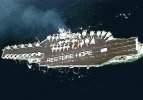 | 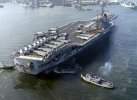 | 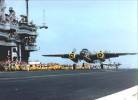 | 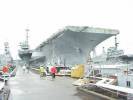 | 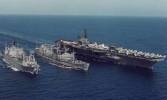 |
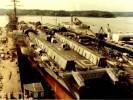 | 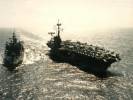 | 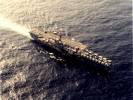 | 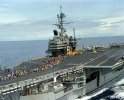 | 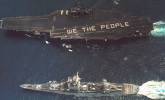 |
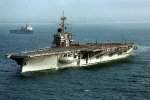 | 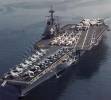 | 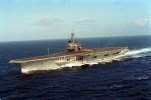 | 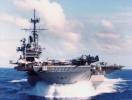 |  |
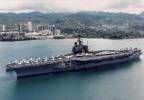 |  | 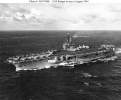 | 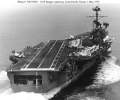 | 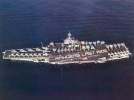 |
The photos below were taken by me and show the RANGER laid-up at the Puget Sound Naval Shipyard, Bremerton, Wash., on March 14, 2010.
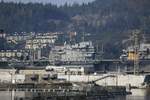 | 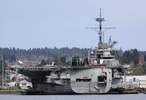 | 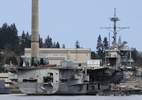 |
The photos below were taken by me and show the RANGER laid-up at the Puget Sound Naval Shipyard, Bremerton, Wash., on May 12, 2012.
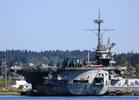 | 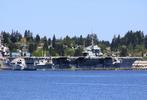 |  | 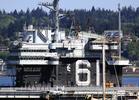 |
 Back to Carriers list.
Back to Carriers list.  Back to ships list.
Back to ships list.  Back to selection page.
Back to selection page.  Back to 1st page.
Back to 1st page.




